- Home
- entertainment
- news
- 18 details you might have missed on 'The Falcon and the Winter Soldier,' so far
18 details you might have missed on 'The Falcon and the Winter Soldier,' so far
Olivia Singh

- Warning: There are major spoilers ahead for "The Falcon and the Winter Soldier."
- The Marvel series, starring Anthony Mackie and Sebastian Stan, features callbacks to the MCU.
- There are other sneaky details and references you might have missed.
The voiceover at the start of the first episode was from "Avengers: Endgame."
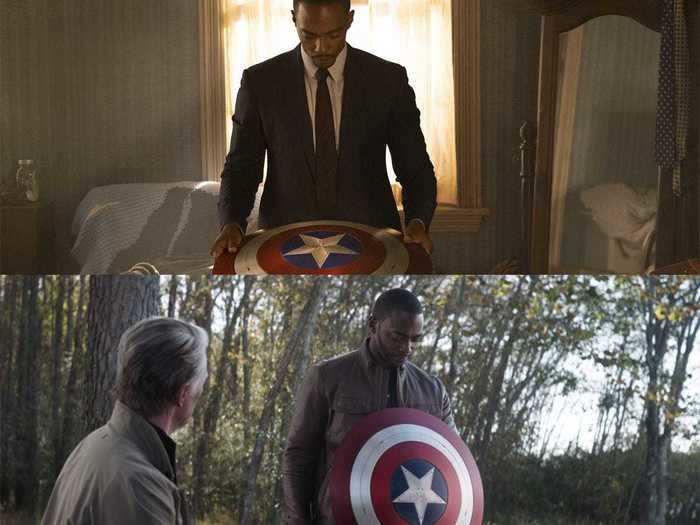
Near the conclusion of 2019's "Avengers: Endgame," Steve Rogers/Captain America returned from time traveling and putting the Infinity Stones exactly where he got them from.
But Steve also took a detour and lived a long and fulfilling life with Peggy Carter. When he returned to the present day as an old man, he took his shield out of a brown case (the same one seen in "TFATWS") and gave Sam his blessing to "try it on."
"How does it feel?" old Steve asked Sam.
"Like it's someone else's," he replied.
"It isn't," Steve said, giving his blessing and smiling up at him.
After a pause, Sam thanked Steve and said "I'll do my best" before they shook hands.
"That's why it's yours," Steve said, showing that he was confident that Sam was worthy of taking up the mantle.
That scene perfectly set up Sam's spin-off series and the concept of legacy that's at the forefront of "TFATWS."
While on a mission to retrieve the military liaison being held captive by a criminal organization known as LAF, Sam fought Batroc - a character last seen in "Captain America: The Winter Soldier."
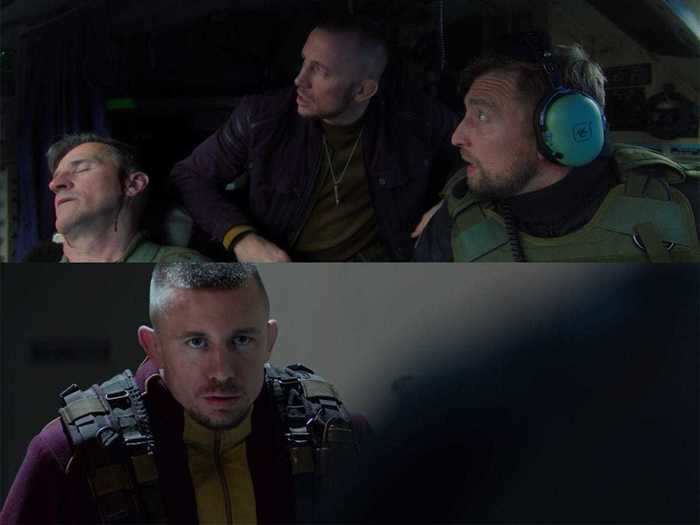
Captain America faced off against Batroc (played by three-time UFC Welterweight Champion and MMA star Georges St-Pierre) when he and Natasha Romanoff/Black Widow were sent on a mission to free hostages from a hijacked S.H.I.E.L.D. ship called the Lemurian Star.
It was later revealed that Batroc was actually hired by Nick Fury to attack the ship to distract from Natasha's actual mission to steal top-secret files. Batroc escaped and was later found in a safe house in Algiers.
It's unclear how Batroc fits into "TFATWS," but clearly the mercenary is still carrying out missions. He's also wearing his comic book counterpart's signature colors.
Even though Tony Stark sacrificed himself in "Endgame" and is dead, his name lives on and loomed over the first episode of "TFATWS."
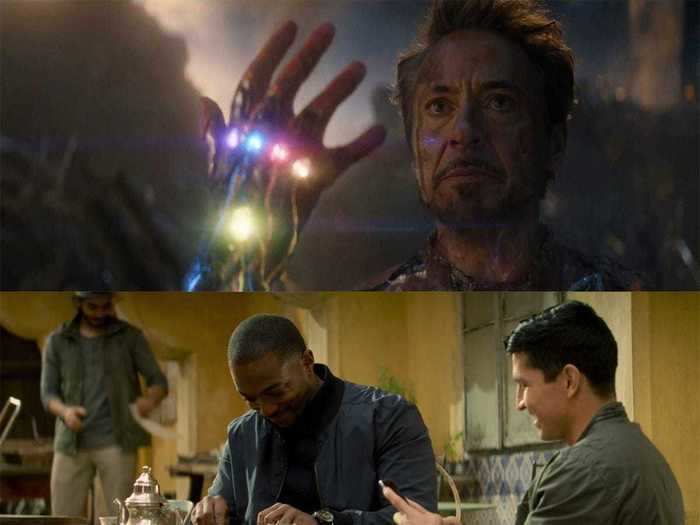
The events of episode one took place six months after "Endgame."
The first mention of Tony Stark/Iron Man came from First Lieutenant Joaquin Torres, an intel officer who works closely with Sam.
After successfully rescuing the military liaison, Sam and Torres took a break in Tunisia. There, Torres referred to Sam's Redwing drone as "Stark-level tech."
The second mention of the late superhero came from the starstruck loan officer who refused to let Sam and his sister Sarah take out a loan. After asking Sam if Stark ever paid him for his superhero efforts, he quickly offered his condolences.
The photo of Steve on the farewell banner at the Smithsonian was used in his first Cap exhibit, seen at the start of "Captain America: The Winter Soldier."

On the first episode of "TFATWS," Sam traveled to Washington, DC (which is where he first met Steve) and gave a speech at a farewell ceremony for Captain America.
The banners with the photo of the hero were previously seen when Steve visited the Smithsonian in "Captain America: The Winter Soldier."
One of the screens in the exhibit referenced "Captain America: Civil War."

A screen was dedicated to the Sokovia Accords, legal documents that caused a rift among the Avengers and split them into two opposing groups: Team Cap and Team Iron Man.
The Sokovia Accords were proposed after two events: the destruction caused by the Avengers in Sokovia during "Avengers: Age of Ultron" and the terrorist attack that took place in Lagos, Nigeria.
As a result, people began to view the Avengers less like heroes and more like villains.
The documents were intended to allow the government to keep the Avengers in check, rather than letting the superheroes operate entirely on their own.
The motorcycle seen on display at the Smithsonian is the same one that was part of the previous Captain America exhibit, with a few adjustments.
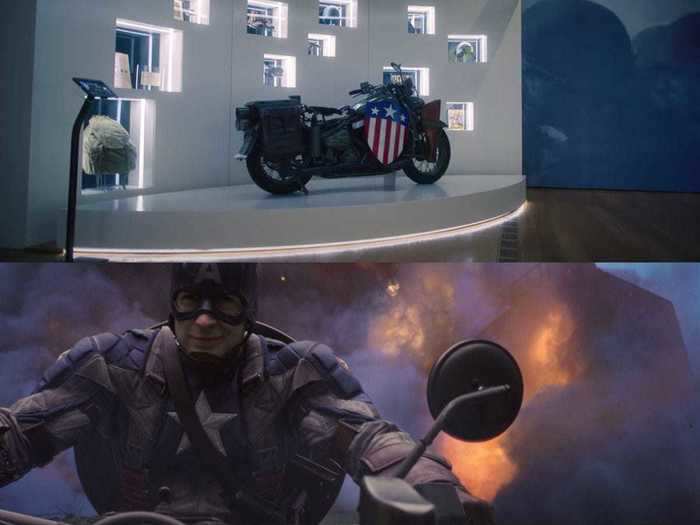
Cap first used a motorcycle in "Captain America: The First Avenger" as he and the Howling Commandos traveled through Europe taking down Hydra's bases.
Steve was seen looking at the vehicle decades later as part of the Smithsonian's section dedicated to the American hero.
On "TFATWS," the motorcycle is now surrounded by mementos on a raised platform.
A new addition is the original shield, which was previously attached to Cap's mannequin. It appears that, after Steve stole the suit in "Captain America: The Winter Soldier" to prepare for battle, the shield was relocated in the exhibit.
Many of the items featured on the wall behind the motorcycle were nods to the first "Captain America" movie.
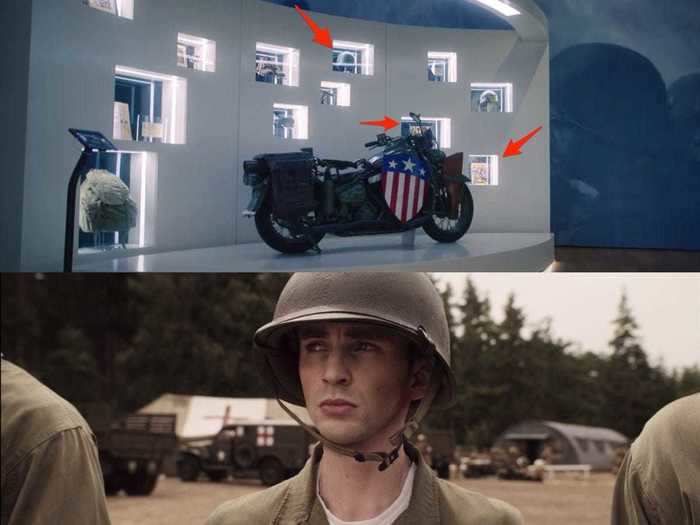
One of the items was the hard hat that he wore while in basic training at Camp Lehigh.
Another was the Captain America comic book, which was printed after he became somewhat of a celebrity as he encouraged Americans to support war efforts in the first "Captain America" movie.
Other pieces on display included a backpack, brown boots, and Captain America trading cards.
Additional screens that Rhodey and Sam walked by as part of the exhibit referenced landmark past events in the MCU.
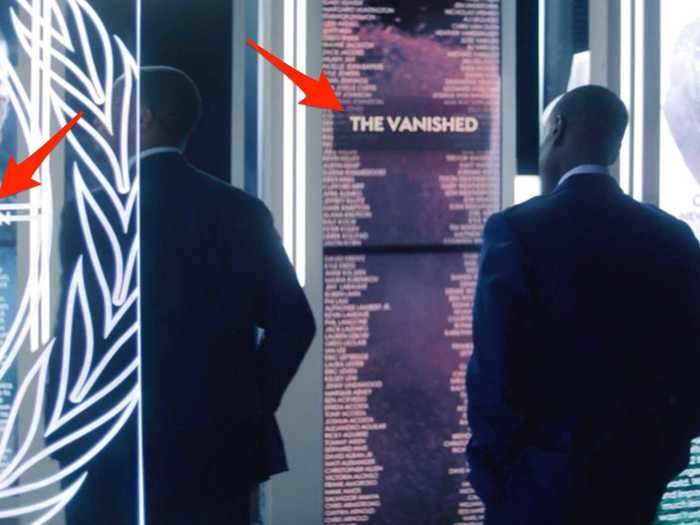
The screens featured titles like "The Blip," "The Vanished," and "Out of Hiding: New York Under Attack."
These headlines were referring to events of "Avengers: Infinity War" and "Avengers: Endgame."
Thanos' followers invaded New York at the start of "Infinity War," years after the 2012 Battle of New York that formed the Avengers.
"The Vanished" referred to the lengthy list of people who were dusted and disappeared when Thanos acquired all the Infinity Stones, snapped his fingers, and wiped out half of the population.
"The Blip" is a term first used in "Spider-Man: Far From Home" when referencing the people who were dusted and then resurrected five years later by Tony Stark.
A screen titled "One Final Mission" referred to the events of "Endgame."
If you look closely at the text, it summarized the plot of the blockbuster movie. It recapped Steve and the Avengers regrouping after five years "with a new plan to undo the damage inflicted by the mad titan known as Thanos."
It also said that the heroes were successful, but with "personal loss" – specifically mentioning the death of Tony Stark.
"With this exhibit, we honor the life and legacy of Steve Rogers, Captain America. Patriot, soldier, hero," the screen text concluded.
Symbols for Hydra and S.H.I.E.L.D. could also be seen.

These two organizations were the focus of several movies within the MCU.
Hydra is marked by a logo of a skull with six tentacles. In "Captain America: The First Avenger," this Nazi rogue science division was led by Johann Schmidt/Red Skull.
S.H.I.E.L.D., a counter-terrorism and intelligence agency, was co-founded by Peggy Carter and Howard Stark after WWII. It was later run by Nick Fury.
In "Captain America: The Winter Soldier," it was revealed that S.H.I.E.L.D. had been infiltrated by Hydra since the very beginning.
More nods to "Captain America: The First Avenger" popped up on the collage of screens in the exhibit.
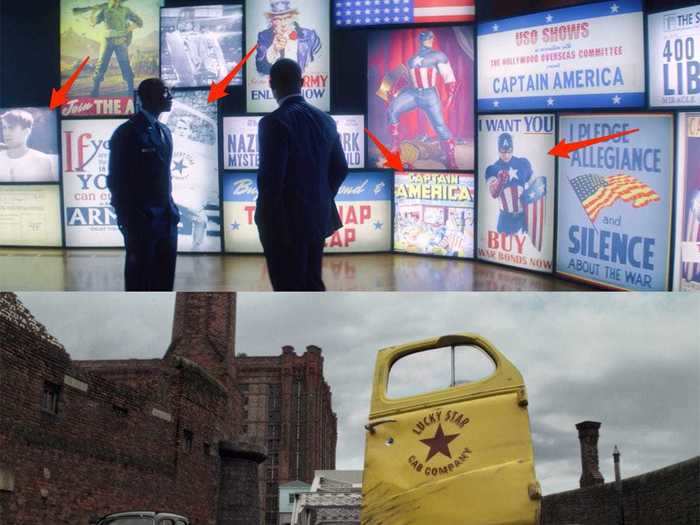
The image of Steve holding the taxicab door was from "Captain America: The First Avenger," after he had successfully been transformed into a super-soldier and pursued a Hydra agent through Brooklyn.
In the movie, he grabbed the broken-off taxi door and used it as a shield as the agent shot at him.
There was also a photo of Steve from when he enlisted in the army. This same image was seen in the file Peggy looked at after she believed Steve died in "Captain America: The First Avenger."
The photo again popped up in the Smithsonian exhibit from "Captain America: The Winter Soldier."
The ads encouraging people to buy war bonds and the image of the Captain America comic book were both featured in a montage from the first movie, when Cap became the poster child for America's WWII efforts.
Bucky sleeping on the floor might be a callback to "Captain America: The Winter Soldier."
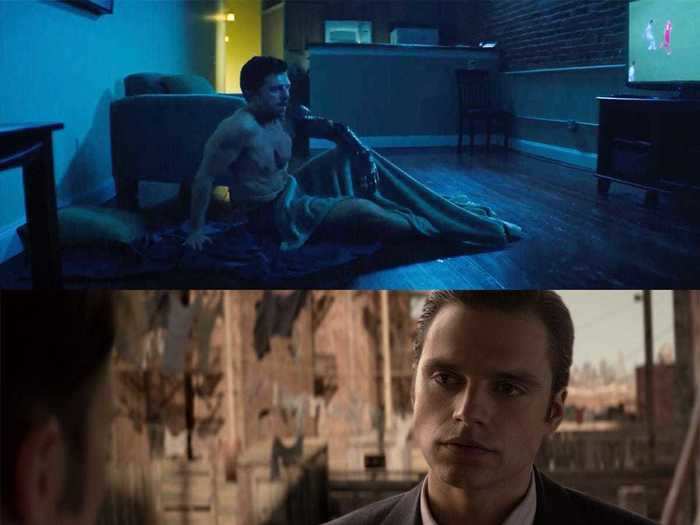
The 2014 movie included a flashback that took place after the funeral for Steve's mom, who died from tuberculosis. Without either of his parents (Steve's dad served in the 107th infantry and died from mustard gas), Bucky offered to let Steve stay at his family's home.
"We can put the couch cushions on the floor like when we were kids," Bucky said.
After Steve politely declined and said he'd be fine on his own, Bucky said, "I'm with you 'til the end of the line, pal"— a line that Steve repeated to Bucky later in the film in an attempt to get his old friend to remember who he was.
Perhaps sleeping on the floor reminds him of his childhood memories with Steve.
Another (more likely) explanation for Bucky sleeping on the floor can be found earlier in "Captain America: The Winter Soldier" when Sam and Steve first met.
Sam immediately realized that Steve was probably having trouble sleeping at night because, strangely enough, his bed was too soft.
Sam, who served in the army for two tours, said that while he was there, he "would sleep on the ground and use rocks for pillows like a caveman. Now I'm home, lying in my bed and it's like…"
"... lying on a marshmallow," Steve said, finishing the sentence. "Feel like I'm gonna sink right to the floor."
Bucky fought in WWII as part of the 107th infantry, so it's possible that he chose to sleep on the floor rather than a bed in "TFATWS" because it feels more grounded and he's still having a difficult time adjusting to regular life.
It's unclear if Bucky even has a bed in his sparsely decorated apartment. There was already a pillow and a blanket set up on the floor, suggesting that Bucky intentionally chose to sleep there rather than on the chair next to him (or his bed, if he has one).
One of the names on Bucky's list of amends is P.W. Hauser, likely a nod to Stan's "I, Tonya" costar Paul Walter Hauser.

Episode one of "TFATWS" revealed that Bucky has several names written in a small notebook, which he calls a list of amends. He's been working through the list to fix past mistakes made during his assassin days.
One of the names included is P.W. Hauser. It's unclear if this is a character, someone who wrote or edited for Marvel comics, or just a clever nod to Hauser the actor. Hauser also reacted to the Easter egg on Twitter.
Hauser played Stan's bodyguard and friend in "I, Tonya," which was based on the life of figure skater Tonya Harding (played by Margot Robbie).
Another name on the list is H. Zemo - possibly referring to "Captain America: Civil War" villain Helmut/Baron Zemo.
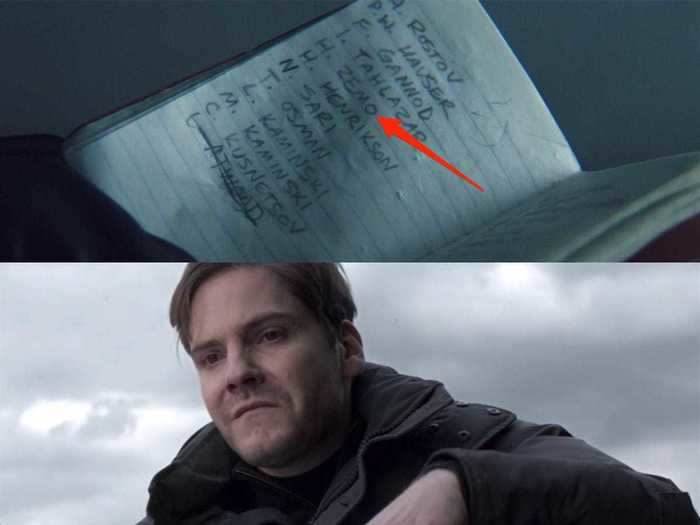
Zemo was the main villain of "Captain America: The Winter Soldier." He wanted to eradicate superheroes after the Avengers ended up being responsible for the deaths of his family members in Sokovia.
The Winter Soldier was a key person in his plan to turn the Avengers on each other.
Fans already know that Zemo will return as the antagonist in "TFATWS," still on a mission to eliminate superheroes.
There are additional names in Bucky's book that might have ties to the comics.
A. Rostov could refer to a Marvel villain named Andre Rostov, known as Red Barbarian. And L. Kaminski might be a nod to Marvel comics writer and editor Len Kaminski.
Bucky referenced his time in Wakanda during a conversation with his therapist.
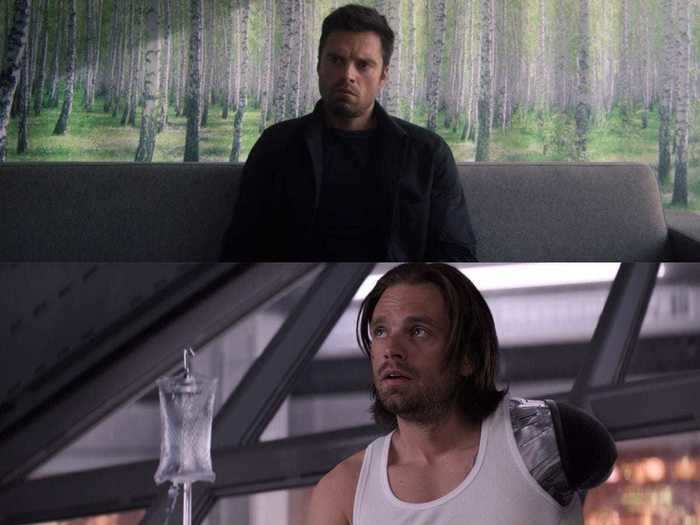
Bucky told Dr. Raynor that civilian life was all new to him because he "didn't have a moment to deal with anything."
"I had a little calm in Wakanda and other than that I just went from one fight to another for 90 years," he said, referring to his time rehabilitating.
The mid-credits scene of "Captain America: Civil War" showed that Bucky was being treated in Wakanda and voluntarily put in cryogenic sleep until they found a way to fix the brainwashing.
Bucky showed up again there during the end-credits scene of 2018's "Black Panther."
During the end-credits scene, Bucky emerged from a small hut, with a cloth wrapped around his upper body to conceal his arm injury. The children called him "White Wolf." When Shuri asked how he was feeling, Bucky replied, "Good. Thank you."
Bucky was seen again in "Avengers: Infinity War," when the superheroes traveled to the nation to extract the Mind Stone from Vision.
T'Challa said that Bucky "rested long enough" and then gave Bucky a new vibranium arm with gold accents in preparation for the big fight against Thanos and his army.
Bucky told his neighbor Yuri that he "hasn't danced since 1943, it feels like."
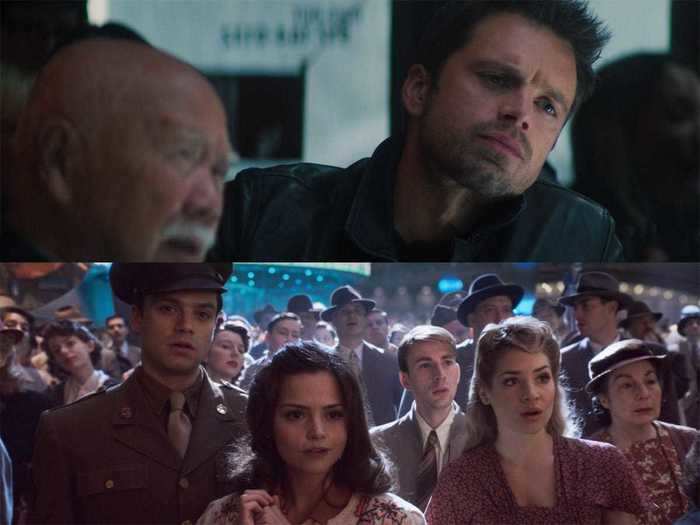
This could be referring to the night Bucky and Steve spent out together at the World's Fair in Queens, NY in "Captain America: The First Avenger."
It was supposed to be a double date with two women before Bucky was shipped out to England the next morning to serve, but Steve was awkward and Bucky was much smoother. So, the two women stayed close to Bucky the whole night as Steve wandered off.
While Steve tried to enlist in the army again after four failed attempts, Bucky left to go dancing with the girls and warned his friend not to do anything stupid until he returned.
That night was the last time Bucky got to enjoy civilian activities before his life changed forever.
Bucky's menacing Winter Soldier score played after Yuri lamented the death of his son, indicating that Bucky's still haunted by his past and struggling to move on.
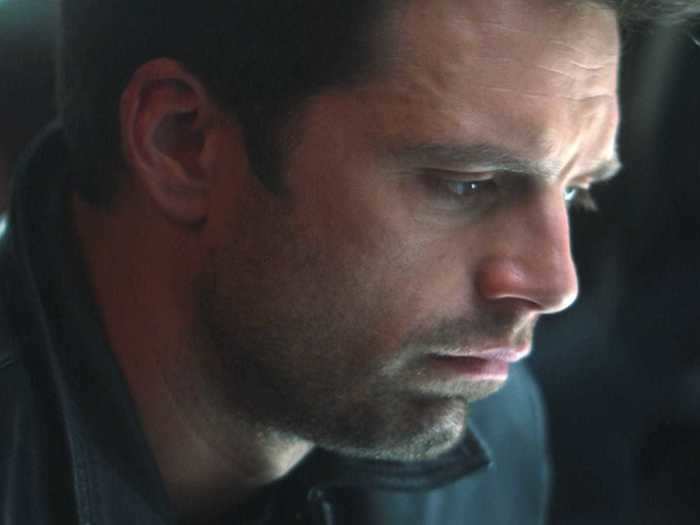
It was later revealed that Yuri is on Bucky's list of people to make amends with because he killed his son back when he was the ruthless assassin known as the Winter Soldier.
Yuri's son wasn't supposed to be murdered, but he was in the wrong place at the wrong time as the Winter Soldier was carrying out a mission.
The return of this score makes sense because Henry Jackman, who composed the scores for "Captain America: The Winter Soldier" and "Captain America: Civil War," is also part of the crew for "TFATWS."
Sam, like Anthony Mackie, is a Louisiana native.
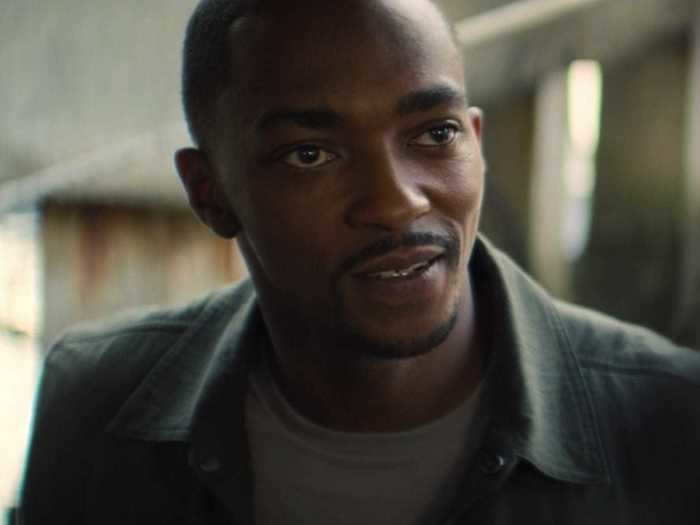
This is one of many things that fans learn about Sam on "TFATWS."
Prior to the show, not much was known about Sam's life aside from his time in the army. The first episode showed Sam traveling to Delacroix, Louisiana to reunite with his sister and his two nephews.
Mackie was born and raised in New Orleans, Louisiana. He later attended the prestigious Juilliard School in New York City.
Sam's pickup truck license plate is 184 EJE, which might be a nod to a comic book issue.
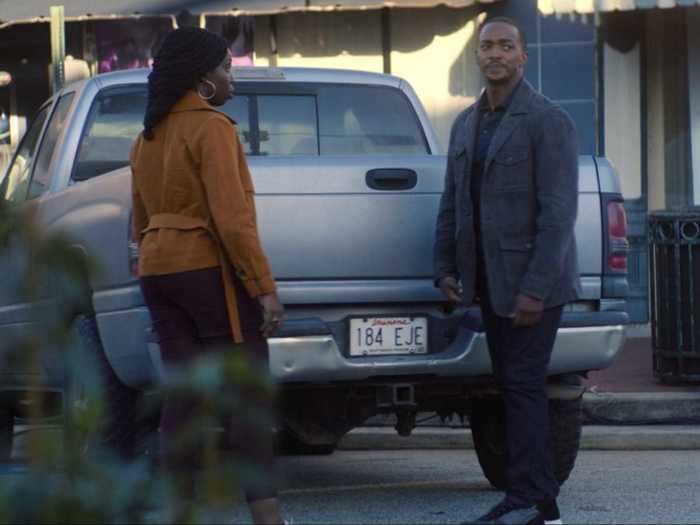
"Captain America and the Falcon #184" was published in 1975 and featured the return of Steve Rogers as Cap.
READ MORE ARTICLES ON
Popular Right Now
Popular Keywords
Advertisement